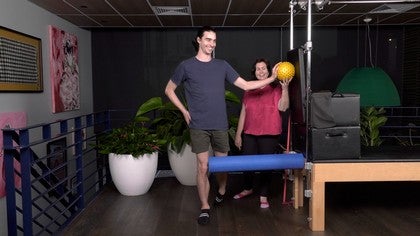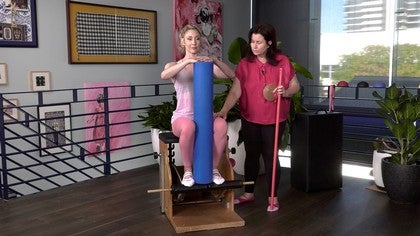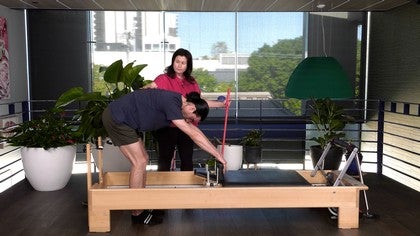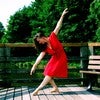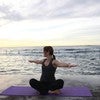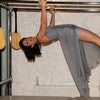Description
About This Video
Transcript
Read Full Transcript
(upbeat music) Hello, and welcome to Wunda Wobble. This series is using our Wunda chair. Now I have a split pedal Wunda chair. You don't need it, I do like it for certain things but if you haven't got a split pedal, this is fine. This one also works really well with the electric chair if you have one.
We need our Wunda chair, our foam roller. I have a Makarlu timber base for some things. If you don't have that, you can maybe get a piece of plastic or something to put on top for some rotational work later. And if you have tight ankles I just use something like a Makarlu or a hedgehoggy sort of thing to put underneath your ankles. We'll tell you when these are just modifications they aren't necessarily, if you don't need the props to support.
This class focus is a strengthening class but it also has the capacity to work on your visual and vestibular systems. In other words, to work on balance, hence wobbly, those of who don't know, wobbly is slang or chucking a wobbly is slang in Australia for throwing a tantrum, but we're not going to throw a tantrum. We're just going to get strong, but also work on our balance systems. I will cue two different ways and you can choose which ones you want to take. So, Lisa, you're going to come on in.
Thank you very much. So Lisa is going to be our model today. I'm going to keep this kind of light. I'm going to keep this only on one lower spring on each pedal, but if you want to, you can make it heavier. Just no know that whichever one you have we're going to try and work the whole session through on that spring setting.
So, Lisa, can I get you to please sit on the edge of the Wunda chair, gluteal crease on the edge right there. Thank you. And what we're going to do is put your feet on the pedal and we're going to start just with the foam roller between her legs. Now what I want you to make sure when you are doing this, you are going to have pressure on the sit bones equally back, put your hands on top on the foam roller, and just use that as a nice passive assist. What you're going to do is just press the pedal down and then allow the pedal to come up with control and to use this as a passive way of raising your arms.
For some of you who have had frozen shoulder or have shoulder restrictions, this is a really nice way of helping you build range of motion for your arms in a supportive way. I like having the foam roller here. You're going to squeeze as you do so pressing down and up we're going to do 10 as your magic number for this series. Remember to keep your ribs coming back just that little bit so that you are not locking in to your spine. We're keeping a nice balanced spine for this first exercise.
I like to think that the foam roller and the spine are the same direction. Lisa will tell me when she's up to 10 and up. This is number eight Nice and controlled. This is your 10th one. So now you're going to push the foam roller down and just take your hands just a little bit wider.
And this time I want you to have your wrists pressing into the side of the foam roller and your fingers pressing down into the top of the foam roller. You'll squeeze your hands into the edge as you activate your rhomboids, just that little bit there. Now what Lisa's going to do and you are too is you're going to roll your spine back into a bit of a C curve as you let the legs come up, controlling the foam roller and having that little bit of abductor squeeze as you do so. And as she now presses the legs down she's going to let herself come into a slight extension lifting your chest up, then roll back into a C curve. I like to think of this as a seated pelvic curl, curl, articulate the spine coming forward and up.
Now, when you are doing this if you are looking at this from a perspective of balance we will cue your eyes as well. So what I'd like you to do is start with your eyes on the top of the foam roller. And as your chest goes forward you slowly take your eyes lead with your eyes taking your eyes up to 12 o'clock and then lowering your eyes down to six o'clock in a nice smooth flow. Remember that balance incorporates the visual system and being able to track your eyes is a very important part of organizing your balance. Nice.
Don't throw your neck too much, Lisa, as beautiful and long as it is and down and there, that's seven, three more. Remember inhaling as you lift your chest and take your eyes up. Exhale, rolling your spine back into your C curve. One more, really fill the ribs, rhomboids working and active. We're now going to take your foam roller and put that flat on the floor.
On the other side of the pedal okay nice. I'm going to let you put your heels on the pedal and you are going to put your hands just on top of the foam roller and press your hands down. We're going to make sure that your back is pressing right back so that the ribcage is pressing into the stick if you've got a stick, this time as you move you're pressing into the foam roller to give yourself lift and you're going to press your legs down and hinge forward, eyes on the rings. Just doing a nice flat back hinging forward coming back slowly hinging back, pressing forward, going to do 10. What I like about this exercise, it has that feel of sit to stand, a very important exercise to prepare you for getting in and out of a chair or even getting off a toilet.
And I can tell you these are important functional exercises. So it's very important for you to be able to get up and down functional movement is essential. And just because you're doing Pilates doesn't mean it's not functional. If we're queuing for a balance point of view, we're also queuing to watch the eyes as they track forward and back. Bringing the eyes away and in, four more.
And back. Building your leg strength is very important. And back. Final one? Last one, yeah.
What Lisa is going to do now I'm just putting this here. This is where if you have a piece of plastic or just something to help you is useful. So what we're going to do is I'm just going to take you through the movement first. You're going to use this as a rotator disc. You can use a big rotator disc if you like, that's okay.
Just feel like you're driving one of those big tractor things. Apparently I don't really know much about farms but I sort of imagine this is what it would be like. How's that feel? Lovely. So remember we are going to take the ribs from side to side.
If you like, I'm just going to let Lisa have a rest here and let her legs sit there and just move the ribs. Remember if you're working with clients who have conditions like Hashimoto's or rheumatoid arthritis it's important to give them little tea breaks or rests in between so they don't fatigue. This is a nice one to add in here. If you don't have those conditions and you are wanting to work to a strengthening case, you might hold the bar halfway down as you go from side to side. You're happy with that now, aren't you?
Okay so now what I'm going to do is leave your hand there. And you're going to take your other hand down on the foam roller. So this time we're going to combine a few movements and we're going to really work towards the vestibular challenge. That is the way the ears of working. You're going to hinge forward.
We've already done that movement. You're going to twist the hands and you're going to now drop the head down, uh uh looking at me, look at me, that's it. And then come back up. So you're trying to get the little crystals in your ears moving. So going forward, twist round and what I find is that when you do this if you take your bottom hand and push back and press down and come back up and round, and Lisa's nicely adding in the legwork now.
And down and around, I'm only going to get five each way but this is a really important way of getting your vestibular system working And also opening out the ribs and getting a little bit of rotation into your life. Good work, Lisa, and we're going to change sides. So remember, press down, pull back. If you want, you can, if you have a split pedal you can take the stick out and allow yourself to do different things like side to side. What I particularly liked about using the foam roller is it allows you to close the chain.
It helps people to organize themselves receptively and to give you that bit of feedback to organize when you're feeling fatigued. Nice, how's that feel? Good. What's that, five? Four.
Oh, you can always tell when they want to do something, it's only two, when they don't like an exercise, it's 10. Good. And I'm going to take that off you. Now, can you put your toes back on the bar, please? We're just going to do a little bit of extension focused work.
Now I like to add in the extension focused work but for certain conditions, you know the drill no extension work or keep it kind of limited. So what we're going to do is put the foam roller on the pedal again, and you are going to spiral your fingers out and really bring the heels in. So maybe even take your feet wider. Toes on the bar, you can come up to a semi demi. I shouldn't say that to a ballerina because now we're in too much turnout And really press in maybe a little bit wider.
Maybe bring the foam roller in just a little bit more. Take the heels wider and really squeeze that heel in, nice to feel that, helps a nice way to get that activation and stop her just dropping out into her great turnout. This time Lisa, I'm just going to get you to do five of this one because I don't want you to overload your spine. What I'm going to get you to do is inhale as you let the pedal come up allow your sternum to come forward. Nice, don't forget the eyes.
Then exhale, curl back. You might want to roll the legs in just a little bit on the curl back just to unload the sacrum. Take the time to press your hands down into the foam roller and what you may notice when you are doing this you may find that you tend to put the same hand on top every time. Yes it's okay we all do it. So consciously take the time to apply the other hand as well so, thank you.
And really press down and then come back up. Nice Final one. Now this time, what I'm going to get you to do is take your legs parallel and bring them so the foam roller is down in front of you and you're going to bring your feet a little bit closer please. Now I'm going to push the pedal all the way down. This next exercise is when you may need a prop.
If you have very tight and ankles or limited dorsiflexion you're going to put something like this, a towel something that's not going to move under the heels for when you stand up, if you have good dorsiflexion you won't need that. So Lisa, what I'm going to get you to do is drop your heels down, put your hands on there. We're going to hinge forward. I've made it very aware of it. Hinge forward, come up to standing.
Oh yeah that sit to stand position's not as easy as you think it is. So what we're going to do is just do a couple of those, hinge back and lift, nice. Hinge forward, pressing up and back. If you like, you can do 10, but for today, I'm just going to make you do about four to five. And remember, vary the program and build your endurance.
This is a lot harder than you think. Final one, Lisa and this time you're going to come up to standing. And pressing down into the foam roller. Use that to help support you. Raise the heels, lift the heels up two, three, four, lower two, three, four.
Working your ankles, build your ankle strength and remember to control the muscle strength and load of your calf muscles. I like to do five in parallel and five in turnout. Lisa goes, that's nice for you Carla, I would like to do two and down and then lift your heels up. And what you can do is do this. Then do your sit to stand, then do this, and then do another series of sit to stand.
To build endurance but to grade that work. But for today, we are just going to do it in this order. Final one. Nice. What I'm going to do now is I'm going to take the foam roller and put it out in front.
I'm going to get you to put one hand on there please. Oh, maybe too far. Now what I'm going to get you to is keep the foot same side as your foam roller on the pedal. The other foot is going to step forward. Good.
Now I have my foot on the pedal and I'm going to slowly take the pressure off. Lisa is going to bend her knee as she does so. Good, keeping this knee soft, little bit softer. So what you are going to do now is press your hand into the foam roller, press the foot down. Yeah.
This is not easy. No. But that's okay. If it was easy, we'd be at the gym. We're at Pilates darling.
So I'm going to help grade her for now. So I'm just going to let her lift the leg up just to there. Then press back down. The idea or the cue that I'd like you to think of is that you are dragging your heel back and feel that the heel is coming up towards your sits bones. We want to activate the hamstring.
Pressing down into the foam roller will help you activate for your oblique slings and get a better activation in your glute. How many sets Lisa? Four. We'll make our fifth one, again as you build endurance, you would work up to 10. So on your sixth one, you're going to lift your heel.
This one here. Nice. From there you just need to pulse this back leg down just a little bit. One, two, three, four, five, lower down. Beautiful step back.
Changing legs. Take your foam roller to there. Take a step forward. Remember, keep this knee soft. Not, I don't want you to live in bent knees but I don't want you to click to the practice of hyper extending your knees too much.
Lisa's a dancer if you haven't worked it out. So she has to do that for her profession but I don't want to over strain her ligaments as well. So we are going to do five. Remember, really pressing back into the heel and feel that dragging back to the sits bones or your tissue tuberosities if you want me to be very specific, pressing down, and once she's done that, love it. Can you see the shake of shame?
It's so good. And from there, hopefully you are feeling your tremor of truth and Lisa, you are coming up onto your toes now. I'm going to help you just to control it if need be. I'm not doing the work, she is just five little pulses, six if you wanna be nice Three. Remember we're looking for smooth controlled muscle contraction, down lower step back.
And we can add a couple of more ankle lifts there. Work on your dorsiflexion and control. This is the sneaky way you can build endurance. Don't make them do 10 all at once if they're not ready for it, add five in, have a break do something else and challenge it. Nice.
You quite like that though don't you? Yes. Good, now, Lisa, you're going to step off and we're just going to step to this front. Take it back down, take the other foot back. Nice and controlled.
Good I've got it, you can step off. Very nice. It's always worse when they just go smash. So, and next how's that feel? Good warm my calves.
Lovely. Remember when we're working with clients with Hashimoto's disease, we are wanting to build their feet and their ankles in particular because of those reflexes. What I'd like you to do now, Lisa is we're going to stand side on. Now I'm going to get you to stand side on and place your knee on the pedal. I'll take this so you don't hurt your knee.
So step facing me. Side on and put your knee there. Now, if you are one of those people who have a collapsing arch, we would put something like this underneath your foot to support it. I know some of us shouldn't have collapsing arches but live with it. We're going to be using the foam roller to help with the balance, again.
And you're just going to bend this knee and slowly bend down, working on strengthening your glute and up. Going to do 10 with the foot flat, trying to keep your hips nice and even for this, so this more about getting your ankle working and just getting a little bit of glute stabilization. Nice, really press in to the pedal. And if you were working on a balance, you would progress this to do this with your eyes closed. Not first time round, but add the challenge when they're ready.
Nice Lisa, where are we up to? Four. Oh, Good work. Now she must like that. And what we're going to do next is we're going to drop one hip down.
I like to call this a sachet, it's like a little bit of a drop. We're not sticking the hip out too much, but we're lifting lengthening and lifting that hip, working into your hip hikers and that works your quadratus lumborum, drop and down, just a nice little release and back. And down and up. Observe your ankle. It's a good thing that we've done all of this work to work on your dorsiflexion and see how that helps support you when you are doing this sort of work.
And once you've done your 10 or 12 we'll come off and we are going to do it all on the other side. So. So set yourself up. Remember if you need support underneath your arch, do so. It's not a competition, lower and lift.
And you can see here, you can hold onto this if you need to Lisa, everyone has a special side. It's okay. Lovely. And 10. (cars revving) And if what you want to do is progress.
Not only with the closing of the eyes, what you could would do is add the challenge, move the foam roller forward and back. I feel like I'm meeting the queen when I do this exercise. And back and forward. You have a progression if you're wanting to work towards balance, you had your eyes closing, the moving of the foam roller or you could also add a head turn, either one. And down and then let's do your little sachet.
You've got every prop known to you. Known to woman kind there, haven't you, just your little drop of your hip. And down. And if you want to progress this, what you would do is come up onto your tippy toes because we can always make it harder. But let's master your basics first.
And I feel like that's enough for you isn't it. Yeah. Coming off there, come to standing, take a deep breath check in with your body and I hope you enjoyed. Thank you.
The Teacher's Corner - Playlist 22: Claiming Immunity
Comments
You need to be a subscriber to post a comment.
Please Log In or Create an Account to start your free trial.
